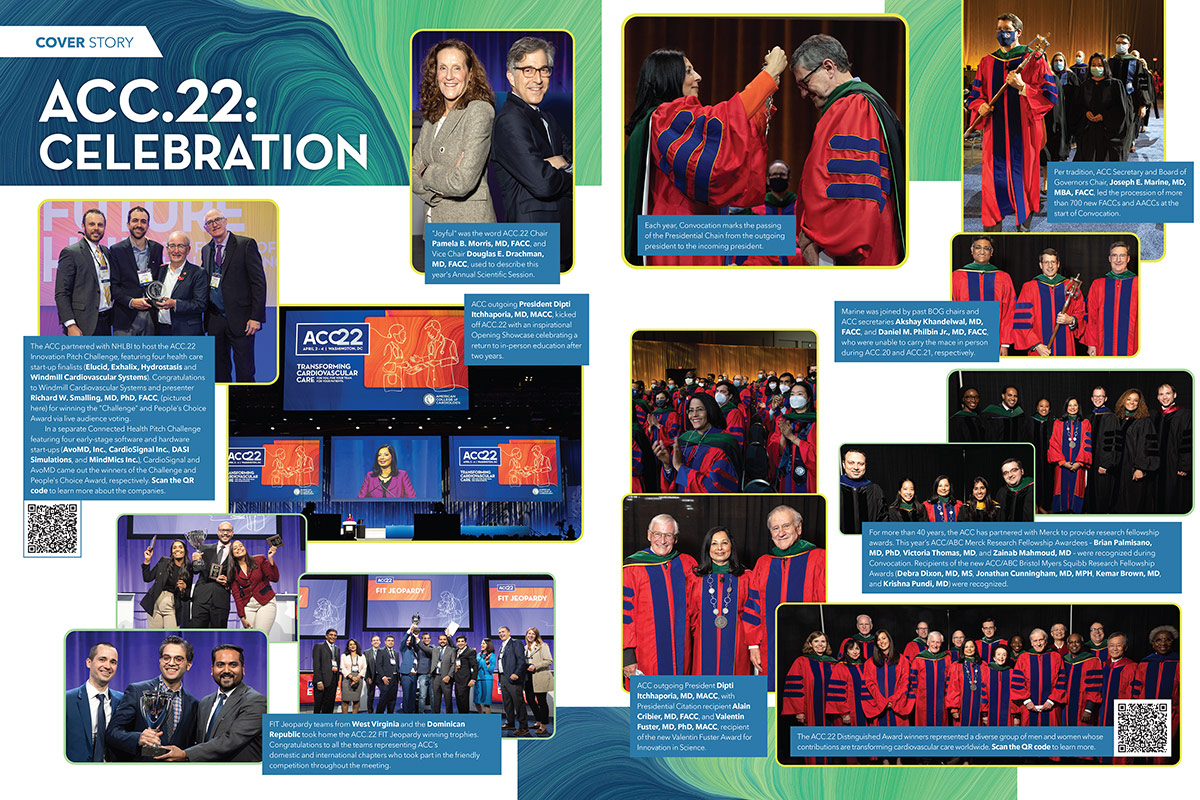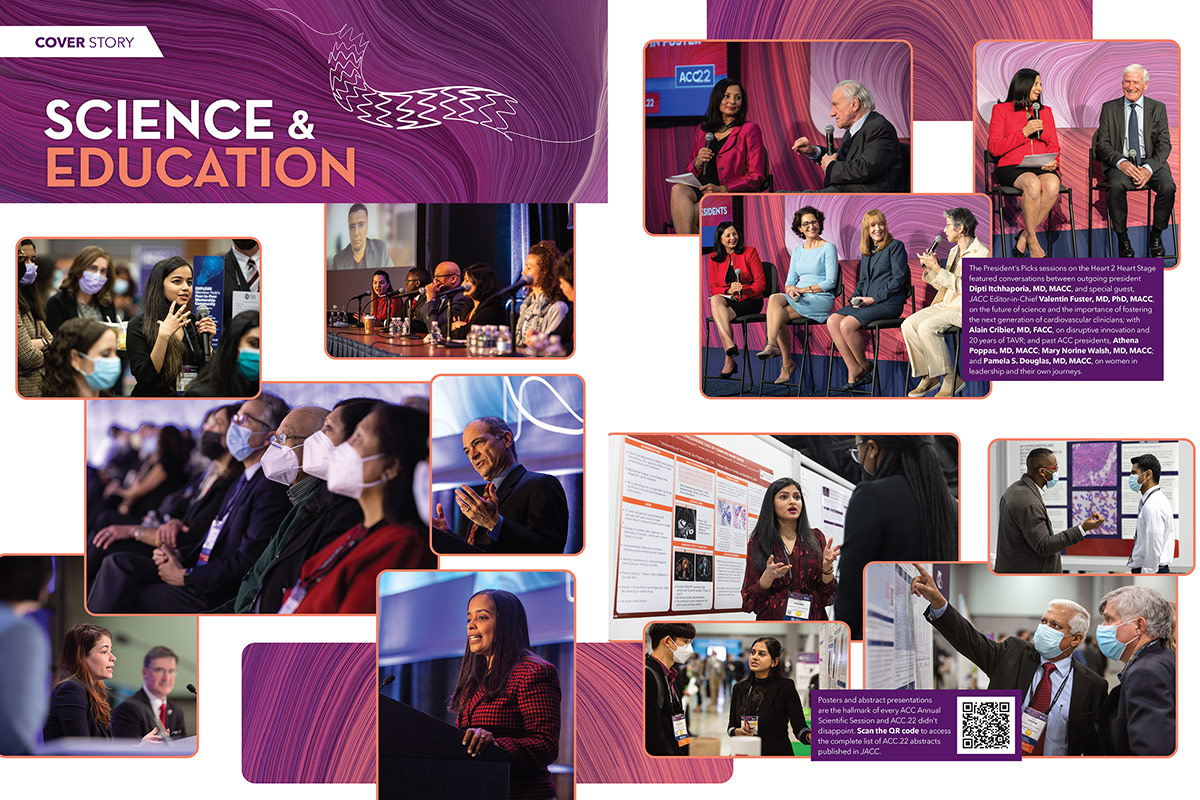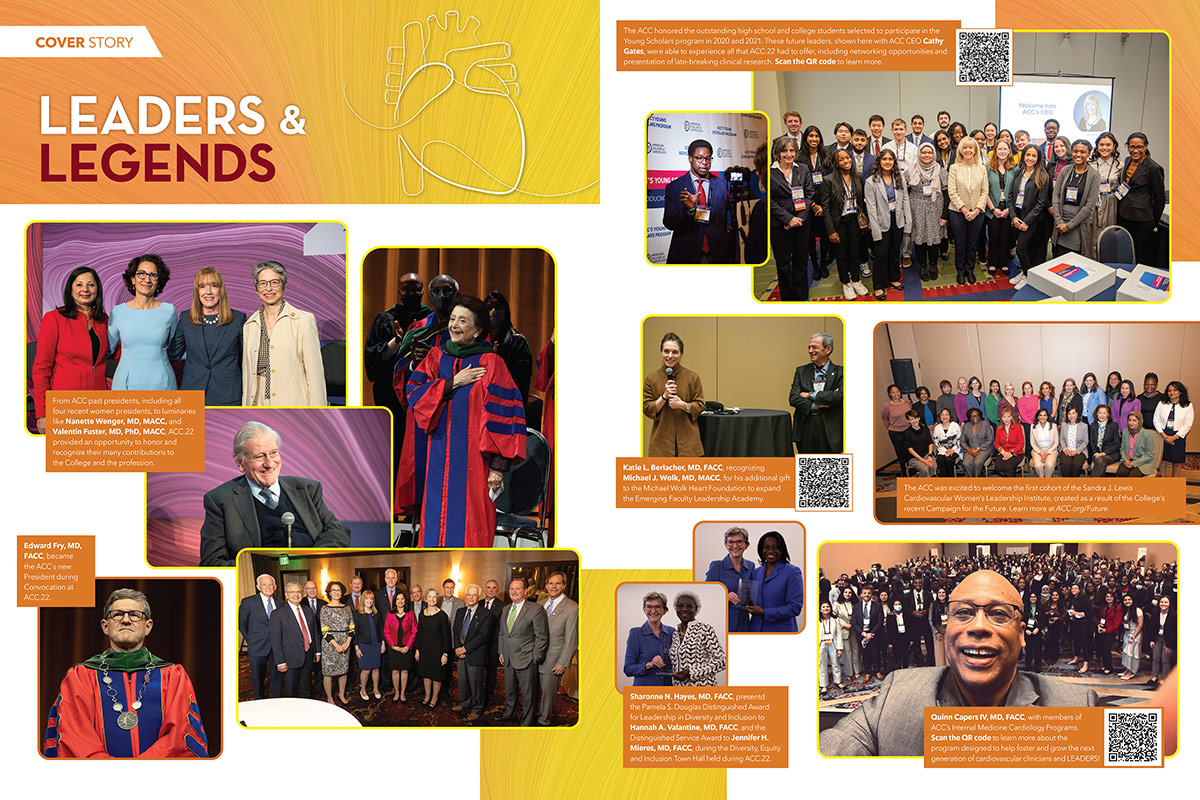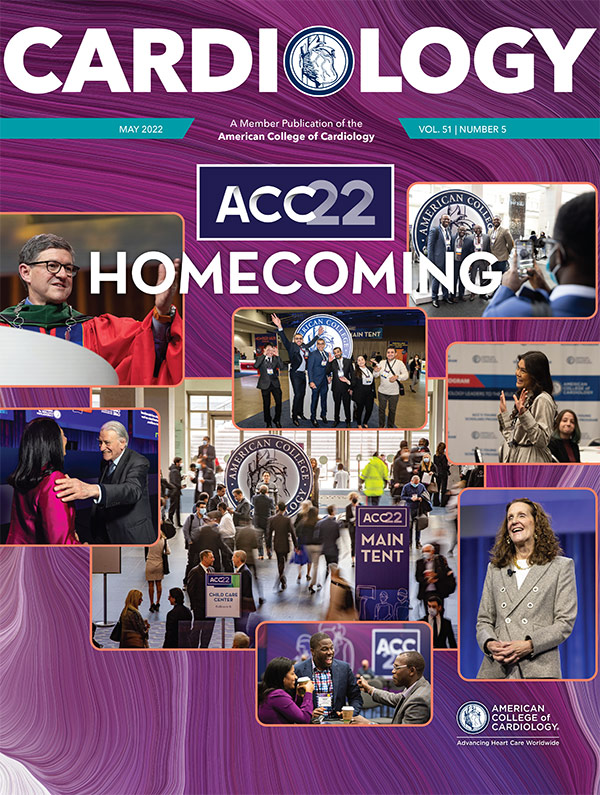Cover Story | ACC.22: Homecoming
The "ACC.22 Scrapbook," celebrates the global ACC community and captures magic moments, and shares glimpses into the innovation, diversity, science and networking that took place over the course of three incredible days, and recognizes leaders new, old and aspiring. Click the right and left arrows below to browse the Scrapbook and click the images for a larger view.
Photo Credit: Photography ©ACC/MedMeeting Images

Expanding Insights on Managing HF
New findings presented during ACC.22 showed that flu shots provide some benefit for patients with HF; nutrition counseling and restricting sodium modestly improves quality of life (QOL) and slows disease progression but doesn't impact harder outcomes; and the delivery of GDMT can be improved with alerts embedded within the clinical workflow via the electronic health record (EHR); along with new data on empagliflozin and omecamtiv mecarbil.
The global IVVE study with 5,129 patients with HF was conducted in 10 countries across Asia, Africa and the Middle East where getting a flu shot is not routine. Participants were randomized to receive a flu shot or placebo annually for up to three years. The composite primary endpoint of cardiovascular death, nonfatal MI or nonfatal stroke occurred in 691 patients and 1,470 experienced the composite co-primary endpoint that included HF hospitalization. No significant difference between groups was seen on a year-round basis. However, separate analyses showed that rates of pneumonia were 42% lower and hospitalizations were 15% lower with a flu shot vs. placebo. And a significant reduction was seen in the primary endpoint, as well as reductions in all-cause death and cardiovascular death, in favor of the flu vaccine during months of the year when infection with influenza virus was common. "When taken together with previous trials and observational studies, the collective data demonstrate there is a substantial benefit to receiving a flu vaccine for people with [HF]," said lead author Mark Loeb, MD.
In the SODIUM-HF study with 841 patients, major adverse events or hospitalizations were not reduced with a dietary intervention of a low-sodium (<1,500 mg daily) diet and nutrition counseling vs. usual care at 12 months. Conducted at 26 medical centers in six countries, the number of primary outcome events was lower but there was no between-group difference. Secondary analyses, however, suggested improvements in QOL with the low-sodium diet as well as longer walking times, although the difference in the 6-minute walk time was not significantly different. "While the intervention didn't reduce clinical events, we found the low-sodium group had modest improvements in QOL and NYHA HF class, which we think will be quite important and valued by patients and clinicians alike," said lead author Justin A. Ezekowitz, MBBCh, FACC. The study will continue to assess patients at 24 months.
A prespecified post hoc analysis from the EMPULSE trial showed that in patients with acute decompensated HF, the SGLT2 inhibitor empagliflozin improved QOL, independent of symptomatic impairment at baseline. The improvement in symptoms, physical limitations and QOL was seen as soon as 15 days and maintained through 90 days. All key KCCQ domains were significantly improved; this was generally consistent across demographics and clinical characteristics. "Our results are of clinical importance, because very few therapies have been previously shown to improve symptoms and functional status in the early post-discharge period in individuals hospitalized with acute HF," wrote the researchers in the simultaneous publication in Circulation. It was previously reported that empagliflozin, vs. placebo resulted in a significant clinical benefit (composite of death, HF events or change in symptom burden) in patients hospitalized with acute HF, regardless of ejection fraction, HF status or diabetes status.
The METEORIC-HF trial showed that omecamtiv mecarbil did not improve measures of exercise capacity over a 20-week period in well-treated patients with HF and reduced ejection fraction (HFrEF). Of the 276 patients on maximally tolerated doses of GDMT, two-thirds were randomized to the addition of omecamtiv mecarbil and one-third to placebo. No difference was found between groups for the primary endpoint of change in peak oxygen uptake as measured by cardiopulmonary exercise testing or in secondary endpoints, including heart and lung function during exercise. No improvement was seen for day-to-day physical activity, as measured by wearable accelerometers, or perceived functional capacity.
In previous trials, omecamtiv mecarbil was found to offer significant benefits for reducing the time to cardiovascular death or first HF event in HFrEF. "This is unfortunately not the first time that there has been a medication that improves outcomes but doesn't improve exercise capacity," said lead author Gregory D. Lewis, MD. "There is a persistent frontier in [HF] to help patients improve their functional capacity, and it seems like we may need to look beyond our current and expanding pharmacotherapy regimen to address this need."
"Targeted and tailored clinical decision support prompts in the EHR can accelerate adoption of underutilized therapies for patients with [HF]," based on findings from the PROMPT-HF trial.
The cluster randomized trial enrolled 100 clinicians in the Yale New Haven Health system who were seeing the greatest number of patients with HFrEF; half were assigned to receive customized alerts in the Epic EHR system and half were not. The alerts listed the medications and doses prescribed, along with the GDMT recommendations for the patient, including beta-blockers, ACEi/ARBs/angiotensin receptor-neprilysin inhibitors, mineralocorticoid receptor antagonists and SGLT2 inhibitors. Clinicians were able to adjust dosing or prescribe additional medications during the same patient visit.
The study, which met its primary endpoint of an increase in GDMT prescribed at 30 days, is the first to show significant improvements in the use of GDMT for HF using a low-cost, scalable intervention to prompt clinicians to prescribe recommended medications, researchers said.
Over about seven months, clinicians saw 1,310 patients with HFrEF. At the study end, 26% of patients whose clinicians received alerts had an increase in the number of prescribed GDMT, compared with 19% of those whose physicians did not (p=0.03). Patients in the clinician alert group were also more likely to receive an increase in the dose for medications they were currently taking. In an evaluation, 80% of participating clinicians reported finding the alerts to be "very helpful."
Good Signals on Valve Durability in TAVR
New data from the CoreValve US Pivotal and SURTAVI trials showed there was significantly less structural valve deterioration (SVD) with TAVR compared with SAVR after five years in patients with severe aortic stenosis at intermediate or high surgical risk.
Researchers analyzed data from 1,128 patients who underwent TAVR and 971 patients who underwent SAVR as part of the CoreValve US Pivotal and SURTAVI trials. SVD was evaluated using Doppler echocardiography.
At five years, the rate of SVD was 2.57% in the TAVR-treated patients and 4.38% in the SAVR-treated patients. The difference in SVD was more profound in patients with smaller (≤23 mm) annuli (5.86% SAVR vs. 1.39% TAVI; p=0.049), but a trend was also found in patients with larger (>23 mm) annuli (3.96% SAVR vs. 2.48% TAVI; p=0.067). Patients in both groups who developed SVD were at about 50% greater risk of all-cause mortality or hospitalization for valve-related disease or worsening heart failure (HF) at five years, the researchers said.
Multivariate predictor analysis found a higher risk of developing SVD in patients with a higher body surface area, and a lower risk of SVD in men, older patients and those with prior PCI and atrial fibrillation.
With TAVR now approved by the U.S. Food and Drug Administration for use in patients of all ages and risk levels who need a replacement heart valve, "heart surgeons tend to worry that in younger, lower-risk patients, replacement valves inserted using TAVR may fail more quickly than surgically inserted valves," said Michael J. Reardon, MD, FACC, the study's senior author. "The results of this study suggest exactly the opposite – that at five years, the TAVR-inserted valve has less structural deterioration than the surgically inserted one."
This study is the largest to assess SVD in patients who participated in randomized trials comparing TAVR and SAVR and the first to show less SVD after five years in these patients, according to Reardon. Establishing the durability of the valves over a longer period remains important. Patients in two ongoing trials, SURTAVI for intermediate risk and Evolut for low risk, will be followed for 10 years to help answer this question.
Fast Takes: CHAP, GHATI & SuperWIN
The CHAP trial found treating mild chronic hypertension during pregnancy was associated with better pregnancy outcomes vs. a strategy of reserving treatment only for severe hypertension. "After many decades of uncertainty, results of this study support the need for clinical guidance to treat mild as well as severe chronic hypertension in pregnancy and to educate patients about the benefits of doing so," said lead author Alan Tita, MD, PhD. "To date, there have been disparate recommendations and hesitancy to treat women with milder forms of high blood pressure during pregnancy for fear of hurting the growing fetus but based on the data, doing so may be good for mom and baby."
Two-year outcomes from ACC's Global Heart Attack Treatment Initiative (GHATI) showed significant improvements in key clinical endpoints, including cardiogenic shock upon arrival at the hospital, cardiac arrest, LVEF <40% and survival at discharge. Also observed was a continued rise in adherence to guideline-directed medical therapy (GDMT), with up to 92% of cases receiving this level of care, up from 90% after the program's first year, and a sustained high rate of reperfusion therapy, which was reported in 95% of STEMI cases, as well as a 75% success rate in patients undergoing PCI within 90 minutes of first medical contact.
GHATI, launched in 2019, uses data collection and localized education around GDMT to improve MI outcomes in low-middle income countries by working directly with medical centers on targeted improvements. Participation is free and voluntary and hospitals agree to collect certain data points related to STEMI care and share the deidentified data with GHATI. To date, the program has tracked STEMI treatment metrics and outcomes for more than 4,000 patients at 39 medical centers in 18 countries on five continents. Other findings from GHATI presented during ACC.22 suggested that significantly fewer women in low-middle income countries are treated for STEMI compared with men, as well as their U.S. women counterparts.
The SuperWIN trial demonstrated that a personalized nutrition education in a series of sessions conducted at participants' regular grocery store significantly improved adherence to the Dietary Approaches to Stop Hypertension (DASH) diet. An innovative partnership between academic researchers and the grocery retailer Kroger, the trial is the first to deliver a nutrition intervention in each participant's home grocery store guided by their personal food purchasing data. The intervention significantly increased DASH adherence scores by 4.7 points on top of an enhanced standard of care group's gain of 5.8 points. An additional 3.8 points were gained by combining in-store nutrition education sessions with online tools and training. Results were sustained at six months.
Young Scholars Program: Research Highlights
High school and college students in the Young Scholars Program, designed to spur interest in science and cardiology, attended ACC.22 and saw science in action. Each student was paired with an ACC Fellow and given the opportunity to participate in their mentor's research. Here's a sampling of the research presented:
COVID-19 Pandemic Limits Research and Mentorship Opportunities
A survey conducted by Theodora Alese and Vaani Panse Garg, MD, of pre-health undergraduates at the Georgia Institute of Technology found the majority of the 21 respondents had not found medicine-related research or work opportunities during the COVID-19 pandemic. Nearly all found it difficult to find a mentor in medicine. Despite this impact from the pandemic, most were still interested in medicine, and nearly half said COVID-19 increased their interest in the field of public health.
Health Knowledge Influences CV Health Behaviors In Young Adults
An online survey conducted by Sanyu Kigudde, et al., found that among the 248 young adults in the U.S. who responded, better knowledge about cardiovascular health was associated with healthier behaviors, but not necessarily with self-reported health status. They concluded that identifying gaps in health knowledge may offer important avenues for improving cardiovascular health behaviors among young adults.
Kidney, Liver Recovery Associated With RV Diastolic Function Post Heart Transplant
Aditi Patel, et al., reviewed data from 60 patients who underwent heart transplantation at the University of Florida Health between September 2015 and February 2021 to assess the relationship between liver and kidney function and recovery of allograft right ventricular (RV) diastolic function in those without manifest graft dysfunction. Through an analysis of kidney and liver markers and RV end-diastolic pressure and nadir-to-plateau time at two weeks and at one, three, six and 12 months post heart transplant, they concluded that liver and kidney function may be associated with RV diastolic dysfunction that usually recovers by 12 weeks post heart transplant.
AI and Echocardiography in MIS-C
Srihita Dasari, et al., reviewed 17 quantitative echo variables demonstrating functional and flow parameters in 2,586 patients (mean age 5.8y±5.8), of whom 277 had Multisystem Inflammatory Syndrome-in-Children (MIS-C). Light gradient boosting machines were used to predict MIS-C characteristics. They found that in MIS-C, primary hemodynamic change occur through left ventricular-outflow/chamber dilation with hyperdynamic function, thus maintaining stroke volume and hemodynamic demand.
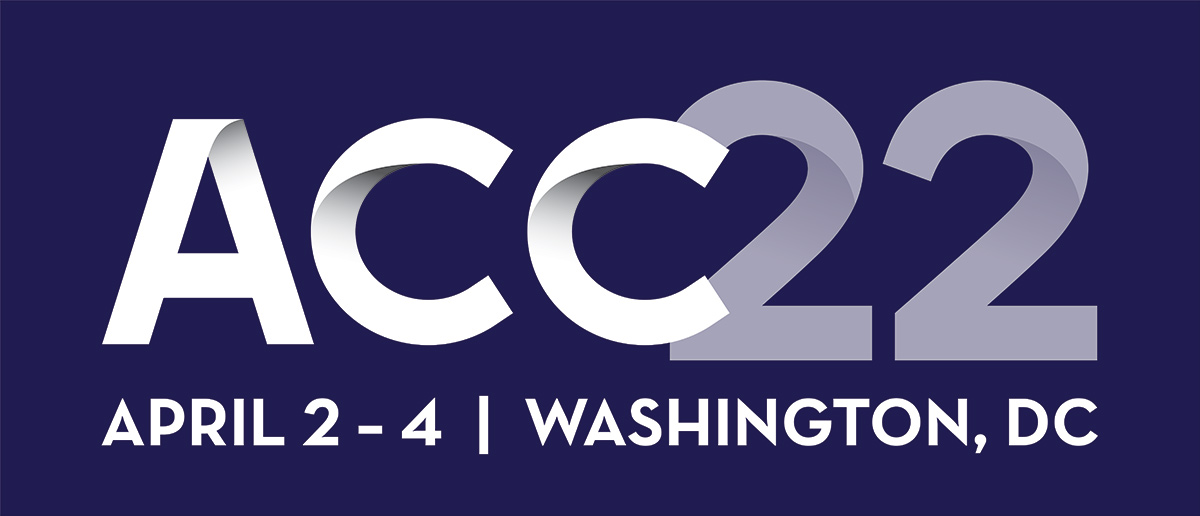
Visit the ACC.22 Meeting Coverage page at ACC.org/ACC2022 for all the trial summaries/updates, news stories and visual abstracts, as well as wrap-up videos and podcasts.
Clinical Topics: Arrhythmias and Clinical EP, Cardiac Surgery, Cardiovascular Care Team, Congenital Heart Disease and Pediatric Cardiology, COVID-19 Hub, Diabetes and Cardiometabolic Disease, Heart Failure and Cardiomyopathies, Invasive Cardiovascular Angiography and Intervention, Noninvasive Imaging, Prevention, Stable Ischemic Heart Disease, Valvular Heart Disease, Implantable Devices, SCD/Ventricular Arrhythmias, Atrial Fibrillation/Supraventricular Arrhythmias, Aortic Surgery, Cardiac Surgery and Arrhythmias, Cardiac Surgery and CHD and Pediatrics, Cardiac Surgery and Heart Failure, Cardiac Surgery and SIHD, Cardiac Surgery and VHD, CHD and Pediatrics and Arrhythmias, CHD and Pediatrics and Imaging, CHD and Pediatrics and Interventions, CHD and Pediatrics and Prevention, CHD and Pediatrics and Quality Improvement, Acute Heart Failure, Heart Failure and Cardiac Biomarkers, Heart Transplant, Interventions and Imaging, Interventions and Structural Heart Disease, Interventions and Vascular Medicine, Echocardiography/Ultrasound, Diet, Exercise, Hypertension, Chronic Angina
Keywords: ACC Publications, Cardiology Magazine, ACC22, ACC Annual Scientific Session, Accelerometry, Africa, Aftercare, Allografts, Angiotensin Receptor Antagonists, Angiotensin-Converting Enzyme Inhibitors, Aortic Valve Stenosis, Artificial Intelligence, Asia, Atrial Fibrillation, Benchmarking, Blood Pressure, Body Surface Area, Cardiology, Counseling, COVID-19, Decision Support Systems, Clinical, Developing Countries, Diabetes Mellitus, Diet, Dietary Approaches To Stop Hypertension, Dilatation, Disease Progression, Echocardiography, Echocardiography, Doppler, Electronic Health Records, Exercise, Exercise Tolerance, Fear, Fetus, Functional Status, Georgia, Health Behavior, Health Status, Heart Arrest, Heart Failure, Heart Transplantation, Heart Valves, Hospitals, Hypertension, Influenza Vaccines, Kidney, Liver, Lung, Maximum Tolerated Dose, Mentors, Middle Aged, Neprilysin, Orthomyxoviridae, Oxygen, Pandemics, Patient Discharge, Percutaneous Coronary Intervention, Physicians, Pneumonia, Pregnancy, Pregnancy Outcome, Quality of Life, Receptors, Angiotensin, Receptors, Mineralocorticoid, Reperfusion, Schools, Self Report, Shock, Cardiogenic, Sodium, Sodium-Glucose Transporter 2 Inhibitors, ST Elevation Myocardial Infarction, Standard of Care, Stroke, Stroke Volume, Students, Supermarkets, Surgeons, Technology, Transcatheter Aortic Valve Replacement, United States Food and Drug Administration, Walking, Wearable Electronic Devices, Workflow, Young Adult

